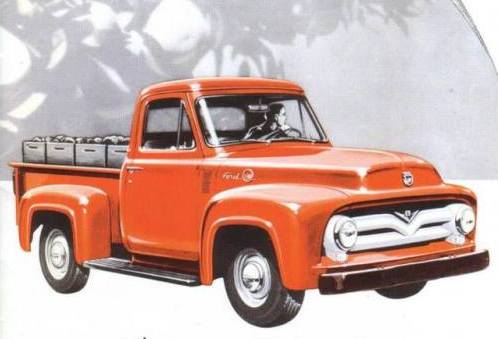
Top Best Pickup Design Picks
As Hagerty Insurance is in the biz of insuring classic and collectible cars it asked its constituents which pickups they thought were the best-looking of all time. A surprising number responded, and the results were recently released. So this is the list of the seven best pickup designs as determined by enthusiasts just like you, in no particular order.
1953-1956 Ford F-100
Many feel these first of the F-100 pickups are the quintessential America pickup design. Totally unique in its day and not aping car design of the period they were introduced in the last year of the venerable flathead V8 engine.

Then, in 1954 it got the all-new “Y-block” overhead V8 adding performance, smoothness, and bringing it into the “jet age.” In 1956 it received a one-year-only makeover with wrapping windshield, new grille, and an optional panoramic rear window available on “Custom Cabs” only.
1947-1954 Chevy Pickup
The 1947 Chevy pickup was the first of the new trucks post-WWII. Round yet contemporary, it blended the fenders into the body rather than looking tacked on. The tried-and-true Chevy “Stovebolt” straight-six was a workhorse, and Chevy sold millions of these trucks over its lifespan.

The truck remained relatively unchanged until 1954 when it received a one-piece curved windshield, a different pickup bed, a redesigned dash, and “bullnose” grille. Hydramatic four-speed automatic transmissions were introduced for the first time. Production continued into 1955 to help with the slow rollout of the all-new 1955 trucks.
1937 Ford Truck
Ford’s 1937 pickup was basically a carryover from the previous two years with one exception. The grille was now leaned back a bit and transitioned into the hood nicely to give a unique look to the three-year-old design. That was enough to set it apart from its earlier incarnations. Bodies, frames, engines, and the beds were all from 1936.

The tall, stately grille worked well with the tall body and separate headlights. Those headlights would not get integrated into the fenders until 1940. The engine remained the venerable “21-stud” flathead V8, but an all-new V8-60 engine was introduced with better fuel economy and less horsepower.
1955-1958 Chevy Cameo
Though production was small, probably due to the price, the first-ever smooth Cameo bedsides forecasted the future of all pickups. Unfortunately, the Cameo’s bedsides were fiberglass add-ons to the standard stepside bed. But by 1960 every pickup manufacturer had all-new flush bedsides with wider pickup beds.

By 1955 the GM trucks were some of the best in pickup design integrating the front fenders into the body. They were taking on more car elements especially inside where the cabins were less spartan and more chrome could be added as an option. 1955 saw the first small-block V8 as an option with the 235 ci straight-six cylinder the standard powertrain.
1937-1939 Studebaker Express Coupe
The Studebaker Coupe Express could actually be the first car/truck as it utilized the passenger car frame, front end, and front body including doors. Then a smooth-for-the-era bed was hung out back. The straight-six was a bit down on power but made up for it in style. These have always been collectible in Stude circles so prices have always been high relative to other trucks of the era. But that is partially due to their rarity. For the three years of production a little over 5,000 were produced.

1973-1987 Chevrolet C-10
Surprisingly, this era of Chevy truck beat out the 1967-1972 trucks, which go for a lot more today. Maybe it’s because there are 15 years of production, or because it’s considered too new for collectors. That would indicate it’s time to buy one.

Both the fleetside beds and step sides are handsome, rugged, roomy, and come in a variety of options up and down the spectrum. We still see them in use from our Motor Biscuit digs in Los Angeles. Big block, small block, straight-six, loaded, strippers, whatever; there is sure to be one that has everything you want.
1963-1971 Jeep Gladiator
In the 1960s-era of high-style the Jeep Gladiator was a throwback to the days of more utilitarian design. But, these were very unique, recognizable pickups adding to the legacy and aura surrounding the Jeep brand. These were not poser pickups.

You could get both two- and four-wheel-drive as well as a dual-rear-wheel option to utilize the two-ton payload the Gladiator could handle. If you were not familiar with the origins of the new Gladiator’s name, now you know.



